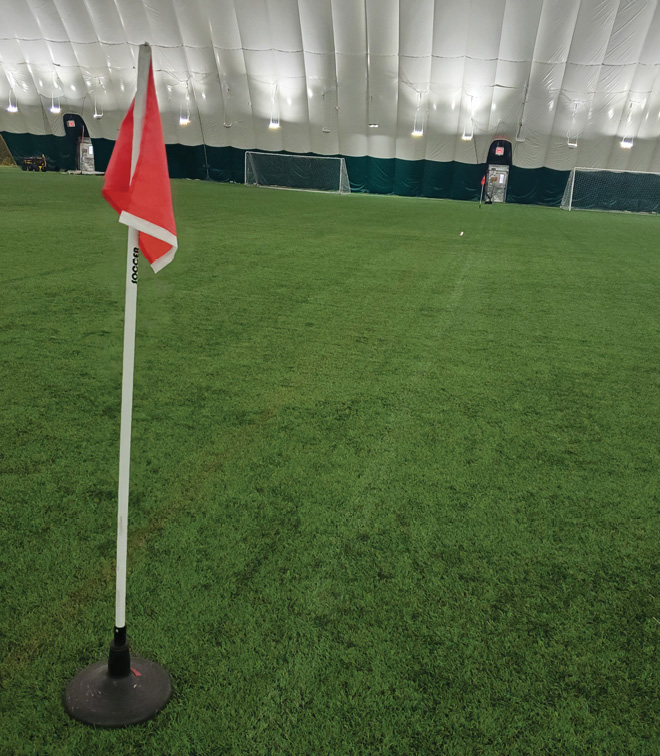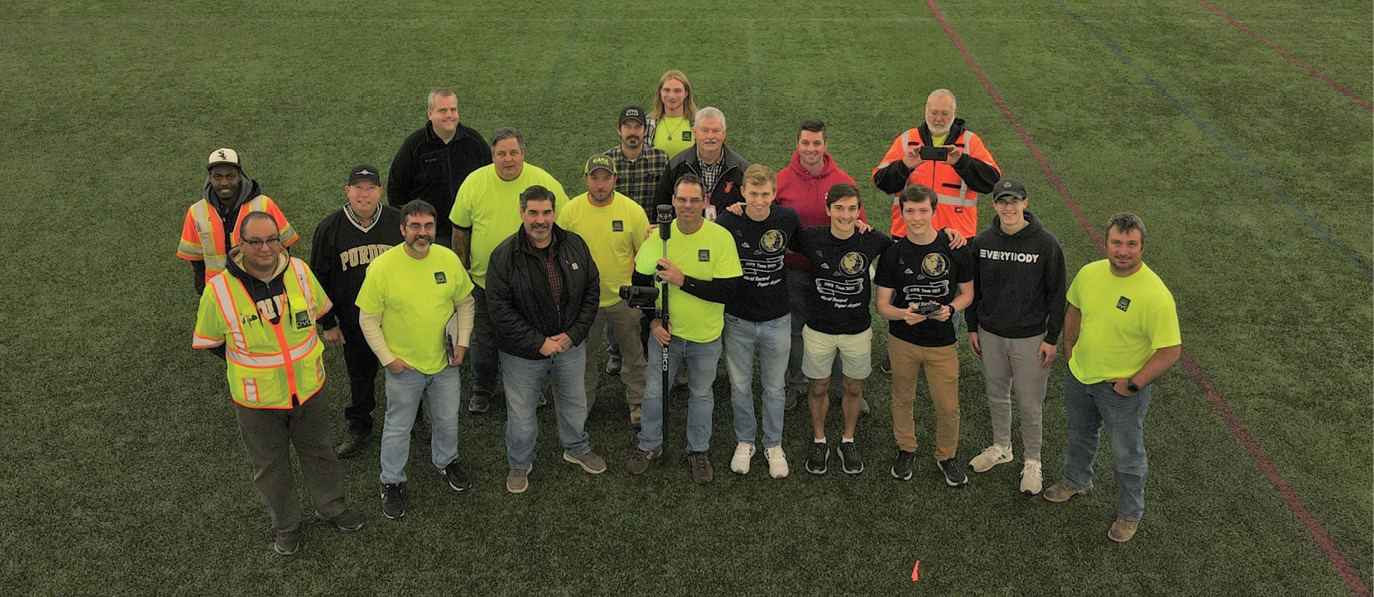Let’s face it. There isn’t a lot about flying paper airplanes that is noteworthy, much less having an article in a magazine on the topic. Flying paper airplanes is, after all, child’s play, a rite of passage even. And how many people can say that on a given boring day at the office, they didn’t make and fly a paper airplane? (Go ahead and admit it. We won’t tell.)
When three aeronautical engineers from Boeing and Garmin got together to meld their know-how to see if they could create a paper airplane that would fly farther than any other, that’s noteworthy, especially when the Guinness Book of World Records certifies their achievement.
That’s precisely what happened last December at The Sparta Dome in Crowne Point, Indiana, when the three, Dillon Ruble, Garrett Jensen, and Nathan Erickson got together to create a paper airplane that would fly farther than any other.
Let the Games Begin
All this started several months before the attempt when, on a lark, the three friends/colleagues began wondering whether they could break the record for “Farthest Flight by a Paper Aircraft.” At the time, the record was held by three South Koreans and a Malaysian since April 2022, who sent their airplane on a flight of 252 feet, 7 inches (77 meters). Prior to that flight, the record had not been broken in more than a decade.
For more than 500 hours, the three put their aeronautical knowledge as well as their origami skills to work to create their airplane.

“It was a lot more work than we had originally anticipated,” Ruble admits. “There is a lot more at work than most people—including us—first thought. Fortunately, there was a point at which we had the airplane created and just fine-tuned it to create the finished product.”
In the actual construction of the finished product, there were not only issues with the design, but the type of paper that would be used to maximize the capabilities of the design and minimize the weight.
Ruble, a systems engineer, worked alongside Jensen, a strength engineer, and flight control systems engineer Erickson. The trio are recent graduates in aerospace engineering and mechanical engineering from Missouri University of Science and Technology.
The engineers put their final design to the test on December 2, 2022, in Crown Point, Indiana, where the record was achieved on Ruble’s third throw.
“We hope this record stands for quite a while—290 feet (88 meters) is unreal,” Jensen said in a press release. “That’s 14 to 15 feet (4.2 to 4.6 meters) over the farthest throw we ever did. It took a lot of planning, work, and a lot of skill to beat the previous record.”
How to Build a Paper Airplane, Engineering Style
The team had decided their best chance at beating the world record would be with an airplane design that focused on speed and minimized drag, so the plane could fly a farther distance in a short amount of time.
Gathering inspiration from various hypersonic aircrafts, vehicles that can fly faster than five times the speed of sound (Mach 5), specifically the NASA X-43A, the team had come up with the winning paper aircraft design — later named “Mach 5.”
“Full-scale and paper airplanes have vast differences in their complexity, but both operate on the same fundamental principles,” said Erickson via email. “Some of the same design methodologies can be applied to both. One of these methods was our trial-and-error design process. For instance, we would theorize about a fold we could change on our plane, fold it, throw it, and compare the distance to previous iterations to determine if the change was beneficial,” said Jensen.
To find the best technique when it came to throwing the paper airplane, the team ran various simulations and analyzed slow-motion videos of their previous throws.
“We found the optimal angle is about 40 degrees off the ground. Once you’re aiming that high, you throw as hard as possible. That gives us our best distance,” Jensen said in the statement. “It took simulations to figure that out. I didn’t think we could get useful data from a simulation on a paper airplane. Turns out, we could.”
Even down to the paper, which the team had decided that A4 (slightly longer than typical letter sized paper) was the best for manipulating and folding into the winning airplane. With these meticulously thought-out design choices, and careful attention to the numerous rules and guidelines set forth by the Guinness World Record Team, the three were set to break the record.
On its record-breaking distance flight, the plane was in the air for roughly six seconds. The Guinness paper plane record for duration of flight is currently 29.2 seconds.
“The design objectives for an air-time record would be vastly different from the low-drag version we built for the longest-distance record,” Ruble said via email. “Increasing the wingspan and decreasing the aspect ratio would be the first steps in producing this type of plane.”
Paper airplanes aside, Ruble added that this tedious method of back-and-forth trials served as a testament to the importance of rigorous prototyping in the real world.
From Origami Enthusiasts to Aerospace Engineers
Ruble and Jensen began their paper plane engineering careers while in middle school, participating in paper airplane events held at Boeing. Ruble said he enjoyed making the paper come to life and the hard work he had to put in to find ways to improve his designs. Both were also fans of origami as kids.
The record-breaking team hopes their accomplishment will inspire other young and aspiring aerospace engineers to chase their dreams.
For those looking to create their own record-breaking paper plane design, the feat is not impossible, but may take some time (and skill). Further, the record-breaking aircraft had to be folded under the watchful eyes of Guinness judges.
“Mach 5 flies best at high relative velocity, but to achieve this condition, the aircraft must be launched in a specific manner,” said Ruble via email. “This technique, in addition to the complexity of the plane, means that only the most experienced paper aircraft enthusiasts would have success with the design.
“However, by starting with publicly available designs, anyone can hone their skills to throw paper airplanes farther and higher than all of their friends,” he added.
Certifying Results
To ensure that everything having to do with their record-setting accomplishment was on the up and up for Guinness, the three contacted surveyor Glenn E. Boren, PLS, Director of Surveying and a Principal of the firm DVG Team, Inc., of Crown Point. As a result, the three friends were watched by two professional witnesses. Boren served as one of them to make sure their exacting standards of Guinness were met, and the beginning parameters as well as the final measurement of the flight length were certified for use by Guinness.
“Guinness Book of World Records holds very exacting standards when breaking a record is attempted,” Boren explained. “My job in this was to provide an independent, professional measurement of the total flight distance in the required format.”
For this project, Boren used a robotic total station to measure the two ends of the starting line with angle and distance utilizing an arbitrary back sight and an assumed coordinate of the station’s position. All of this data was stored in the electronic data collector. After the flight was completed, the landing spot was measured, and the horizontal and vertical coordinate was stored in the data collector, ready for use by data recipients.
Author’s Note: If a reader would like to build their own copy of the record-setting airplane, you’re on your own. The three friends are careful to note that competition for the paper airplane flight record is extremely competitive, so when it comes to how they built their airplane, they aren’t talking.
Michael W. Michelsen, Jr., is a freelance writer based in Southern California. He lives with his wife, Lisa, and two cantankerous Jack Russell terriers, Leopold and Loeb.

